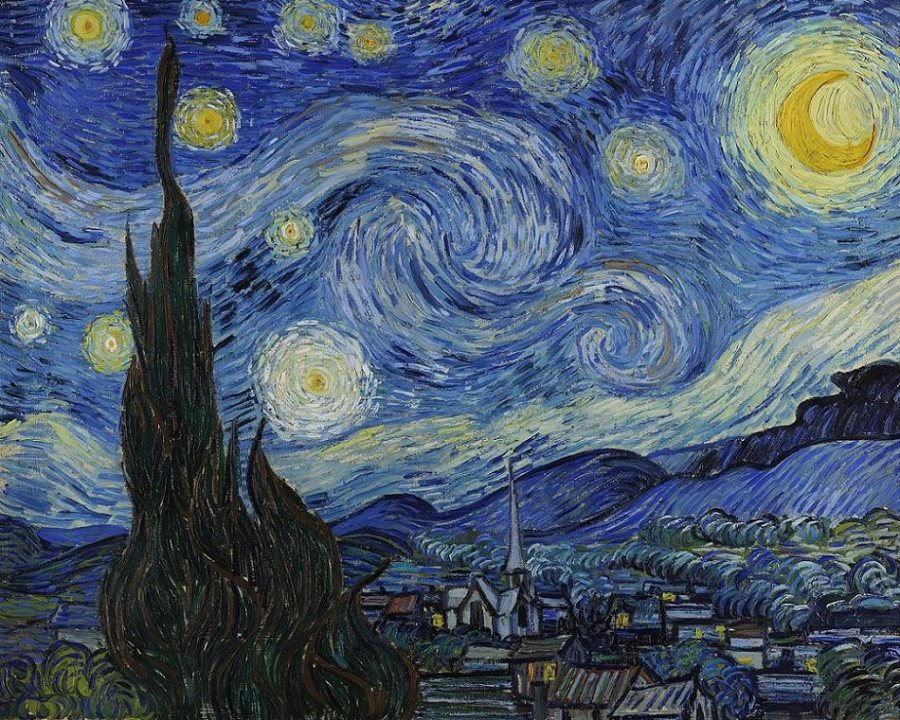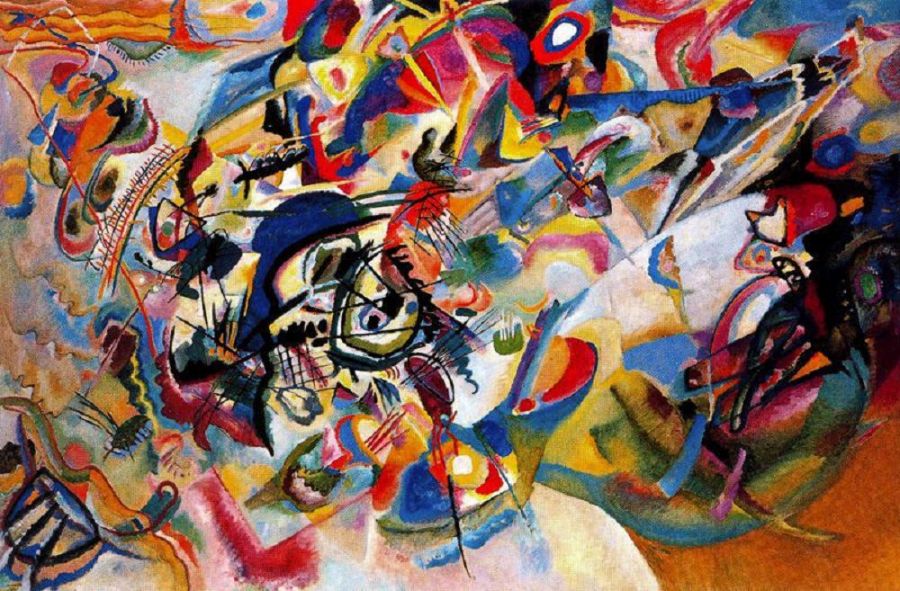Biography -Master of Abstract Art Movement

Kandinsky was born on December 4th ( 16th in Gregorian calendar) , 1866 in Moscow. His father Wassily was a wealthy tea merchant whose family comes from the border region between Mongolia and Manchuria and his mother Lydia was comes from a noble Moscow family. Due to his parents interest in art, he spent his childhood with listening to Russian and German tales and studying piano and cello.
By the time he started art education political events was erupted in Russia. In 1861 serfdom abolished and administration reforms implemented until the death of tsar II. Alexander in 1881 then absolute monarchy re-established by tsar III. Alexander. Meantime in Europe the social balance was disrupted and the social classes was intermingling.

Together with the rise of the proletariat, realist art becomes increasingly important throughout Europe. Realism, demanded art to be unleashed from its traditional order.
In 1885, he registers the university of Moscow faculty of law. Due to his interest in ethnography and his high grades, the ethnographic community of the school sends Kandinsky to the Vologda region to study the culture of Karelian’s (Finnish). The colors of the clothes he saw during the trip and the interior decorations of the settlements taught him to “live in the painting”.
Late 19th Century
At the end of the 19th century, music and theater, along with the acquisition of avant-garde elements, gain importance. Likewise, architecture takes its pay from social and industrial evolution then, centuries of practice become history. Sciences such as medicine, physics and chemistry make progress with important inventions. Together with scientific discoveries, the perception of art tends to positivism. Moreover, Positivism regards art to concentrate into visible reality.
In the words of Kandinsky, “the only thing that satisfies the soul”, art dominates the law and after his visit to Paris in 1889, he concentrates on art. 1898 was the year of three events in which Kandinsky decided to devote his life to art. The first event he saw in an impressionist exhibition was the objectlessness of Monet’s straw painting.

The second event was the representation of Wagner’s Lohengrin drama in the Bolshoi and the third event was the disintegration of the atom, which has destroyed the “absolute and absolute concreteness of the perceptible.”
The last decade of the 19th century was the most turbulent period. The secession stream encouraged creative experiments and symbolism has prevailed in art and literature. Realism has lost its importance, and all attention is directed to parallel reality movement of reality that the eye cannot see but the brain grasps. Psychology, optics and physics have formed the dynamics of this dimension.

Early 20th Century
Kandinsky moved to Munich, pioneer city of the secession movement, in 1896. He attends Anton Azbé university in Munich and studied on drawing.
During the period from 1901 to 1904 he worked on small oil paintings with spatula, watercolor paintings inspired by the Middle Age, more detailed paintings and graphics on canvas.

When he was in Paris in 1906, his brush strokes began to change with the effect of Fauvism (an art movement developed by Henri Matisse in France between 1898-1908). In 1909, he founded the Neue Künstlervereinigung (a new ensemble of artists), due to enthusiastic and stimulating art environment. This community aimed to develop impressionism.
Kandinsky defines his works after 1909, the stages of his progression towards the abstract as improvisations, impressions and compositions. According to him, “nature and forms are obstacles that block the path of the human soul to the top and therefore they should be eliminated”. “Thus the human spirit will be able to attain the perfect freedom of the flow of life that feed its imagination with sound and color”.

1910 was the most important year for Kandinsky. His paintings became as interesting as painters like Matisse, Boccioni and Picasso. In 1913, his book of autobiography (called retrospect) was published. After a while the First World War breaks out (in 1914) and he returns to Russia.
The artist now makes extraordinary paintings by “searching for the infinite potential of the abstract”.

In September 1916, he met Nina Andreevska, the daughter of a pro-tsar officer. Influenced by Nina’s voice over the phone, Kandinsky dedicated a painting to her. Later, in February 1917, they got married.

The tsarist Russia, which lost its power in the First World War, had also been weakened by the revolt and strikes from the proletariat. The environment developed by these events has created the possibility of revolution for the Bolsheviks led by L. Trotsky and V.I. Lenin. In October 1917, Tsar Nikolay II was deposed and the Bolsheviks declared USSR.

After the revolution, it is accepted that art is for the people and esthetics of industrial design have gained importance. January 1918, Kandinsky starts to work for state institutions and enters the department of fine arts of the public education institution. In October, he takes over the management of an art studio and continues his work here. Rising Avant-Garde movement before the revolution, Constructivism and Suprematism; contribute to the new industrial structuring process of the state with their importance to mechanization and geometric abstraction.

In 1920 he was asked to establish the Moscow Institute of Art Culture. Kandinsky prepares a program for this purpose and becomes the head of the art department. Kandinsky contradicts the constructivists in the institute and then leaves Moscow with his wife, arrives in Berlin in December 1921.

Impressionism, New–Objectivity and Dada movements, which embraced the German capital and criticized abstract art, made Kandinsky feel lonely about his art.
He published paintings such as composition VII, which he rationalized and developed his ideas in the improvisations of the Munich period, and was exhibited at the Bauhaus (school of fine and applied art in Weimar, Germany) in 1923.

Bauhaus, becomes the target of the sectarian German regime established after the First World War. The government tried to slander Kandinsky to attack the academy. the school is closes as a result of the events related the politics (it will be reopened later in Saxony). Kandinsky, while working in Bauhaus (Dessau, Saxony) during the productive period of his career, in Italy and Germany fascism rises.
By the end of the 1920s, fascism gained strength in Italy and the intellectuals were silenced. In 1933, Hitler was elected President, while Stalin forming his order in Russia and America was dealing with the economic crisis. Meanwhile, art and literature meet Andre Bréton’s surrealist manifesto in 1924, Paris. The main theme of surrealism was on the description of the subconscious.
The national socialists, who gained strength in saxony, attempted to close the school and the school was closed in 1933. In December, Kandinsky and Nina decide to move to Paris. Entering a period of social stagnation, Kandinsky minimizes communication with the world of art.
As the first half of the 20th century was about to end, the second world war began with the invasion of Poland by the Nazis. Kandinsky continues to work even in the seventies, can not find interest in his art. In 1944, he died without any pain due to illness in his brain and spinal cord.

O.S. Tapsin
Resources: Paola Rappelli, ArtBook, Kandinsky, ISBN 975-8457-62-4, Elemond , Martello, Venice — https://www.wassily-kandinsky.org—https://www.biography.com/artist/wassily-kandinsky — https://www.wassilykandinsky.net/book-118.php —

Hi there just wanted to give you a quick heads up and let you know a few of the images aren’t loading properly. I’m not sure why but I think its a linking issue. I’ve tried it in two different internet browsers and both show the same results.
LikeLike
Hi Nichole, thank you for informing. Could you please specify the problem ? I’ve checked, everything seems fine.
LikeLiked by 1 person
As I web site possessor I believe the content material here is rattling fantastic , appreciate it for your hard work. You should keep it up forever! Good Luck.
LikeLike
Hello! I’ve been following your website for a long time now and
finally got the bravery to go ahead and give you a shout out from Houston Tx!
Just wanted to mention keep up the fantastic work!
LikeLike
This is a topic which is near to my heart… Thank you! Where are your contact details though?
LikeLike
I very lucky to find this site on bing, just what I was looking for : D as well saved to fav.
LikeLike
Good post. I certainly appreciate this site.
Continue the good work!
LikeLike
Great post. I was checking continuously this blog and I’m impressed!
Extremely helpful info particularly the last part 🙂 I care for such info a lot.
I was seeking this particular info for a long time.
Thank you and best of luck.
LikeLike
Great goods from you, man. I’ve take note your stuff
previous to and you’re simply extremely magnificent.
I really like what you have obtained here, certainly like what you’re stating and the way wherein you say it.
You’re making it enjoyable and you still take care of
to keep it smart. I can not wait to learn far more from you.
That is actually a wonderful website.
LikeLike
Hmm it looks like your website ate my first comment (it
was extremely long) so I guess I’ll just sum it up what I had written and
say, I’m thoroughly enjoying your blog. I as well am an aspiring
blog writer but I’m still new to everything. Do you have any recommendations for inexperienced blog writers?
I’d really appreciate it.
LikeLike